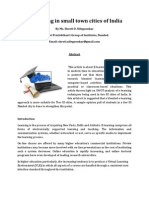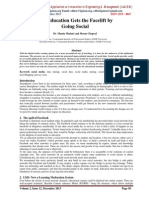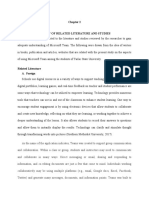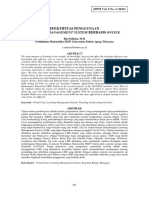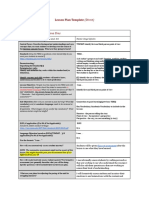Professional Documents
Culture Documents
Interactive and Collaborative E-Learning Platform With Integrated Social Software and Learning Management System
Interactive and Collaborative E-Learning Platform With Integrated Social Software and Learning Management System
Uploaded by
spenzakuOriginal Description:
Original Title
Copyright
Available Formats
Share this document
Did you find this document useful?
Is this content inappropriate?
Report this DocumentCopyright:
Available Formats
Interactive and Collaborative E-Learning Platform With Integrated Social Software and Learning Management System
Interactive and Collaborative E-Learning Platform With Integrated Social Software and Learning Management System
Uploaded by
spenzakuCopyright:
Available Formats
Chapter 2
Interactive and Collaborative E-Learning Platform with Integrated Social Software and Learning Management System
Zhao Du, Xiaolong Fu, Can Zhao, Qifeng Liu and Ting Liu
Abstract E-learning featured by active participation, interaction and collaboration of learners and educators is becoming more and more important in education both for learners and educators. While learning management system (LMS) is the traditional approach to e-learning which is organized as courses; social software including blogs, wikis, social networking sites, and social bookmarking sites etc. are adopted by many educators to meet their emerging needs in educations. In order to satisfy the needs for participation, interaction, and collaboration of learners and educators in the cognition, construction, and socialization process of learning; we propose an interactive and collaborative e-learning platform which combines the advantages of LMS and social software by integrating social software with LMS. The platform connects course network of users with his/her social network and knowledge network. As a result, its helpful to users in building their personalized social network and knowledge network during the process of learning. Keywords E-learning Learning management system Social software Social bookmarking sites Social network sites Knowledge management Learning management system
2.1 Introduction
Web 2.0, social web, or read/write web has gained increasing popularity in education and brought profound impact to education since the beginning of the new millennium [1, 2]. On one hand, students nowadays are digital natives who
Z. Du (&) X. Fu C. Zhao Q. Liu T. Liu Information Technology Center, Tsinghua University, 100084 Beijing, China e-mail: dz@cic.tsinghua.edu.cn
W. Lu et al. (eds.), Proceedings of the 2012 International Conference on Information Technology and Software Engineering, Lecture Notes in Electrical Engineering 212, DOI: 10.1007/978-3-642-34531-9_2, Springer-Verlag Berlin Heidelberg 2013
11
12
Z. Du et al.
are accustomed to learn in an active learning environment. On the other hand, the world is changing more rapidly than any other period in human history and people are facing an era of knowledge explosion and globalization. As a result, elearning featured by active participation, interaction and collaboration of learners and educators is becoming more and more important in education both for learners to get better learning experience and for educators to achieve better education effect. Learning management system is the traditional approach to e-learning. Learning in LMS is organized as courses. It usually serves as the online platform for course syllabus releasing, handouts distribution, assignments management, and course discussion to students, teachers, TAs who are the member of the same course. Although LMS such as Blackboard, Moodle, and Sakai has been used by numerous universities all over the world to support and improve learning of their students [3]; it is primarily designed for course management purpose and has limited impact on pedagogy. The primary limitations of LMS include lack of personalized control for learners over learning process, limited interaction channel and collaboration manner between learners and educators, restricted interaction and collaboration scope within courses. These limitations make LMS not competent for supporting e-learning in the new era which views learning as a selfgoverned, problem-based and collaborative social process [4]. Recently, social software including blogs, wikis, social networking sites, and social bookmarking sites etc. are gradually adopted by more and more educators to meet their emerging needs in educations. Although there is no common agreed denition for social software, the core features of social software are to facilitate interaction and collaboration among users. Social software represents a shift to more social, personalized, open, dynamic, emergent, and knowledge-pull model for e-learning [5]. It provides learners with the abilities to direct their own problem-solving process, build connections with a wide variety of people and knowledge, and interact and collaborate with other users [6]. Currently, LMS and social software are mostly provided independently by universities and Internet companies to learners and educators. The advantages of this way lie in exibility and openness. In addition, its also economic for universities because there is no need for additional investment. These advantages take social software into the sight of learners and educators. Some of them will become loyal users of social software gradually and begin to incorporate t social software into their daily activities including learning. The disadvantages of this way are isolation of information and connections in different systems, lack of specic design in function and UI for educational purposes, and unsustainability of service providing for social software provided by Internet companies. These disadvantages will bring barrier to users especially for students and teachers to whose primary activities are learning and teaching. Based on the considerations above, its helpful and signicant for universities to provide an integrated e-learning platform for students, teachers, alumni and even the public which can support their interaction and collaboration in learning and teaching both on campus and out of campus.
2 Interactive and Collaborative E-Learning Platform
13
Based on the considerations above, we propose an interactive and collaborative e-learning platform which integrates social software with LMS. The platform provides personalized space for users where they can interact and collaborate with others. The personalized space of users contains their course network, social network and knowledge network. One of the key features of the platform is that it connects course network of users with his/her social network and knowledge network. Therefore, users are able to build their personalized social network and knowledge network during the process of learning. Moreover, it also facilitates interaction and collaboration between users by providing news feed service, recommendation service, and search service.
2.2 Interactions and Collaboration in LMS and Social Software
Interactions and collaboration in LMS and social software are different in many aspects. Firstly, the scope and during of interactions and collaboration in LMS are limited to a single course, but there is no limitation for the scope and during of interactions and collaboration in social software. Secondly, interactions and collaboration in LMS are group-oriented, and that in social software are the combination of individual-oriented and group-oriented. Thirdly, the form of interactions and collaboration is relatively simple which is mostly based on text and photos, while the form of interactions and collaboration in social software is much richer which also includes audios and videos. Finally, users can accumulate personalized social network and knowledge network during the process of using social software which is impossible in LMS.
2.2.1 Interaction and Collaboration in LMS
The functions of LMS can be viewed from two aspects. The rst aspect is to provide online course management service to educators and administrators within the university that hosts the platform. The second aspect is to provide course-based interaction and collaboration service to educators and learners within the hosting university. In the following paragraph, we are going to focus on the features of the interaction and collaboration services that LMS provides to educators and learners. Interaction and collaboration in LMS is course-based and the relationship between users in a course is temporal and unequal, as described as Fig. 2.1. Learners and educators of the same course can interact and collaborate within the scope of digital space of a common course. Specically, educators can post course announcement and course material to learners, learners and educators can discuss in the discussion form. Since interaction and collaboration in discussion forum is oriented at all members of a
14 Fig. 2.1 Interaction and collaboration in LMS
Z. Du et al.
Digital Space of Course Course Announcements Course Material Sharing Learners Discussion Forum Educators
course and mostly based on text and photos, the form and effect of interaction and collaboration is relatively simple and limited. Its noteworthy that the duration of interaction and communication is the same as the corresponding course which is usually one semester. As a result, everything in digital space of a course will be of no use after the end of the course, and there is no opportunity for users to accumulate personalized social network and knowledge network.
2.2.2 Interaction and Collaboration in Social Software
The key aspects of social software are that it involves shared wider participation in the creation of information, encourage more active learning, and supports better group interaction. Therefore, social software can stimulate learner-educator interaction, increase learners motivation, and fosters a greater sense of community [7]. Social software which is often used in e-learning includes blogs, wikis, social networking sites, and social bookmarking sites [4]. Difference social software provides different forms of interaction and collaboration service to users, the relationship between users is permanent and equal. Social software doesnt have any limitations on duration of group-oriented interaction and collaboration. Different from LMS, all social software provides individual-oriented interaction and collaboration; some of them also provide group-oriented interaction and collaboration, as described as Fig. 2.2. Users can choose to use individual-oriented or group-oriented interaction and collaboration
Fig. 2.2 Interaction and collaboration in social software
User Blogs Wikis Social BookMarking Sites Social Network Sites Group Personal Space of User User Friend Information Group Information Social Network Knowledge Network
2 Interactive and Collaborative E-Learning Platform
15
according to their wishes freely. Interactions and collaboration in social software can not only based on text and photos as LMS, but also based on audios and videos as well. During the process of using software, users can build and expand their personalized social network and knowledge network. There is personal space for every user where he/she can read various kinds of information from his/her friends and groups as well as his/her own social network and knowledge network.
2.3 Interactions and Collaboration in E-Learning Platform with Integrated Social Software and LMS
Some researchers view the key issue in learning is the support of learning as a cognitive and constructive process [8]. Others view learning as a social process, they stress that the challenge today is not what you know but who you know [9]. The former groups of researcher follow learning theory of behaviourism which focuses on externally observable change, cognitivism which focuses on computational models of the individual mind, or constructivism which presents learners create knowledge as they attempt to understand their experiences; the latter groups of researchers introduce constructivism as a new learning theory which presents learning as a connection/network-forming process [5]. From our point of view, we think learning is a combination of cognitive and constructive process with social process. On one hand, cognitive and constructive are about the aspect of learning process of individual learners; on other hand, social is about the aspects of learning resource and environment of many learners. Therefore, participation, interaction and collaboration in learning are important and helpful in the cognition, construction, and socialization process of learning. Interactions and collaboration in e-learning platform with integrated social software and LMS can be described as Fig. 2.3. The platform not only combines functions of LMS and social software, but also provides personalized space for each user. The personal space is the place where users can interact and collaborate with others. There are three categories of information and three types of network in personal space of each user. As they can do in LMS, users can participate, interact and collaborate in his/her courses which are organized as course groups in the platform. Besides, users can also read various kinds of information from his/her friends and groups as well as of his/her own within his/her personal space as they can do in social software. The information is owed to users through the ltering of his/her social network and knowledge network. The key feature of the platform lies in the connections built between the course network of users and his/her social network and knowledge network, as shown by the dotted line in Fig. 2.3. When users participate in a course, he/she has built permanent group connections with other users who participate in the same course. Furthermore, he/she is also possible to build permanent personal connections with all members of the group. By this way, he/she can build and expand his/her social
16
Z. Du et al.
User User User Group Group
Group
Interactive and Collaborative E-Learning Platform Personal Space for User My Information Friend Information Group Information
Course Network
Social Network
Knowledge Network
LMS Course Announcements Course Material Sharing Discussion Forum
Social Software Blog Service
Social Network Service
Wiki Service
Social Bookmarking Service
Fig. 2.3 Interaction and collaboration in e-learning platform
network. At the same time, he/she can create or get useful digital resources. He/she can also make comments on them, add tags to them, share them to other users, and save them as his/her favorite. All additional information of digital resources mentioned above forms the value-added information of original digital resources. The set of original digital resources and their value-added information ultimately constitute knowledge network of users. Social network and knowledge network will provide continuous support for users learning both inside and outside courses.
2.4 Interactive and Collaborative E-Learning Platform
Interactive and collaborative e-learning platform consists of eight parts; these parts can be divided into four layers, as shown in Fig. 2.4. The rst and bottom layer is data layer which keeps all data in the platform. Data layer keeps course data, social network data, and knowledge data. The second layer is core services layer which provides all core services in the platform including course services, social software services, and search services. The third layer is information delivery layer which provides various forms of information services to users. Information delivery layer consists of news feed service, relation recommendation service, knowledge recommendation service, and search service. The last and top layer is user interface layer which is the layer users interact with. The platform offers multiple interfaces to its users including web-based interface, mobile-based web interface, and mobile-based app interface.
2 Interactive and Collaborative E-Learning Platform
17
User Interface Layer Web-Based Interface Mobile-Based Web Interface Mobile -Based App Interace
Information Delivery Layer News Feed Service Relationship Recommendation Service Knowledge Recommendation Service Search Service
Course Service Layer Course Service Course Management Course Registration Course Space Social Software Service Blog Service Wiki Service Knowledge Service Knowledge Acquisition Knowledge Sharing Tagging
Social Bookmarking Service Social Network Service
Data Layer Course Data Registered Courses Open Courses Social Network Data Personal Relationship Group Relationship Knowledge Data Digital Resource Value-added Information
Fig. 2.4 Design of interactive and collaborative e-learning platform
The most important layer to facilitate interaction and collaboration between users is information delivery layer. Services in this layer disseminate different types of information to their target users or possible target users. As a result, users will nd its much easier to build their social network and knowledge network. News feed service push information to users using their social network data. Relation recommendation service and knowledge recommendation service provide users with the information of users, groups, and knowledge that they may possibly interested through intelligent analysis of their behaviors. Search service provides a variety of search services to users including course search, user search, and knowledge search. Moreover, users can search in the scope of the whole platform as well as a specic data set.
2.5 Conclusions
Since students nowadays are digital natives who are accustomed to learn in an active learning environment, interactive and collaborative e-learning environment beyond traditional LMS is needed by both learners and educators. Under this circumstance, learning is a combination of cognitive and constructive process with social process. Social software involves shared wider participation in the creation
18
Z. Du et al.
of information, encourage more active learning, and supports better group interaction. Therefore, we combine the advantages of LMS and social software to build an interactive and collaborative e-learning platform. The platform not only helps users to build their personalized social network and knowledge network during the process of learning, but also connects course network of users with his/her social network and knowledge network. It also provides news feed service, recommendation service, and search service to facilitate interaction and collaboration between users.
Acknowledgments This work is supported by the National Science and Technology Major Project of the Ministry of Science and Technology of China (No. 2009ZX03005-003) and the National Basic Research Program of China (No. 2012CB316000).
References
1. Ravenscroft A (2009) Social software, web 2.0 and learning: status and implications of an evolving paradigm. J Comput Assist Learn 25(1):15 2. Greenhow C, Robelia B, Hughes JE (2009) Learning, teaching, and scholarship in a digital age web 2.0 and classroom research: what path should we take now? Educ Res 38(4):246259 3. Al-Ajlan A, Zedan H (2008) Why moodle. In: Proceedings of the 12th IEEE international workshop on future trends of distributed computing system (FTDCS08), 5864 4. Dalsgarrd C (2006) Social software: e-learning beyond learning management systems. Eur J Open Distance E-Learn 5. Chatti MA, Jarke M, Frosch-Wilke D (2007) The future of e-learning: a shift to knowledge networking and social software. Int J knowl Learn 3(4/5):404420 6. Mcloughlin C, Mark JWL (2010) Personalized and self regulated learning in the web 2.0 era: international examplars of innovative pedagogy using social software. Aust J Educ Technol 26(1):2843 7. Minocha S (2009) Role of social software tools in education: a literature review. Educ Train 51(5):353369 8. Lytras M, Naeve A, Pouloudi A (2005) Knowledge management as a reference theory for elearning: a conceptual and technological perspective. Int J Distance Educ Technol 3(2):112 9. Paavola S, Lipponen L, Hakkarainen K (2002) Epistemological foundations for CSCL: a comparison of three models of innovative knowledge communities. In: Proceedings of the computer-supported collaborative learning 2002 conference, 2432
http://www.springer.com/978-3-642-34530-2
You might also like
- Piano Research ProjectDocument10 pagesPiano Research ProjectAndrew WidgerNo ratings yet
- The Use of Social Networking Platforms As New, Efficient Technology Tools For E-LearningDocument7 pagesThe Use of Social Networking Platforms As New, Efficient Technology Tools For E-LearningIOSRJEN : hard copy, certificates, Call for Papers 2013, publishing of journalNo ratings yet
- Pedagogical View of E-Learning ActivitiesDocument5 pagesPedagogical View of E-Learning ActivitiesResearch ParkNo ratings yet
- Application of Social Software in College EducationDocument3 pagesApplication of Social Software in College EducationDejailson PinheiroNo ratings yet
- Ijet 28273Document6 pagesIjet 28273Hassaan AliNo ratings yet
- Students' Engagement in Distance Learning: Creating A Scenario With LMS and Social Network AggregationDocument7 pagesStudents' Engagement in Distance Learning: Creating A Scenario With LMS and Social Network AggregationAngelica AlejandroNo ratings yet
- Module 4 Lesson 1Document12 pagesModule 4 Lesson 1Trisha Mae CarriedoNo ratings yet
- English Online Courses A Swot AnalysisDocument5 pagesEnglish Online Courses A Swot AnalysisChitvan KhoslaNo ratings yet
- E-Learn 2009 ProceedingsDocument5 pagesE-Learn 2009 Proceedingsmakahaz1No ratings yet
- FLED Manuscript 1Document13 pagesFLED Manuscript 1喜び エイプリルジョイNo ratings yet
- Research Article: Barriers To Participation in Learning Management Systems in Saudi Arabian UniversitiesDocument9 pagesResearch Article: Barriers To Participation in Learning Management Systems in Saudi Arabian UniversitiesSharqNo ratings yet
- Survey On Interactive E-Learning PlatformDocument6 pagesSurvey On Interactive E-Learning PlatformIJRASETPublicationsNo ratings yet
- Learning Management Systems in Higher Education: July 2014Document7 pagesLearning Management Systems in Higher Education: July 2014Kishore SmartNo ratings yet
- Blended Explicacion CompletaDocument57 pagesBlended Explicacion CompletaFreddy MuñozNo ratings yet
- Modified Learning Management System Making A Difference in E - Learning This New NormalDocument9 pagesModified Learning Management System Making A Difference in E - Learning This New NormalIOER International Multidisciplinary Research Journal ( IIMRJ)100% (1)
- Emergence & Significance of Online Education Over Classroom LearningDocument12 pagesEmergence & Significance of Online Education Over Classroom LearningParveenNo ratings yet
- Review of Related LiteratureDocument2 pagesReview of Related LiteratureJohn Alvin B SapunganNo ratings yet
- The Importance of Students' Collabomtion in The E-Learning ImplementationDocument13 pagesThe Importance of Students' Collabomtion in The E-Learning ImplementationKim Hye RinNo ratings yet
- Social Media and Distance Education - de OracleDocument5 pagesSocial Media and Distance Education - de OracleMichael L. Porter100% (1)
- Schoology-Learning Management SystemDocument42 pagesSchoology-Learning Management SystemRechelleRuthM.Deiparine100% (2)
- Module 4 NotesDocument12 pagesModule 4 NotesCharen Mae SumboNo ratings yet
- E-Learning in Small Town Cities of IndiaDocument6 pagesE-Learning in Small Town Cities of IndiaVivek TathodNo ratings yet
- User Luisnogo Social Media in EducationDocument3 pagesUser Luisnogo Social Media in Educationapi-730466737No ratings yet
- 1.3 Information Technology in The Distance Learning SystemDocument7 pages1.3 Information Technology in The Distance Learning SystemKimbat SeitovaNo ratings yet
- Origin of LMSDocument11 pagesOrigin of LMSVolkanNo ratings yet
- CSC 323 HandoutDocument58 pagesCSC 323 HandoutFaisal AliNo ratings yet
- E LearningDocument19 pagesE LearningDharshiny GhayathriNo ratings yet
- Final Chapter 1 To 3Document53 pagesFinal Chapter 1 To 3Neil Joshua AlmarioNo ratings yet
- Implementation of Blended E-Learning Method in University To Creating A Good and Effective CommunicationDocument16 pagesImplementation of Blended E-Learning Method in University To Creating A Good and Effective CommunicationDaniya AriyantiNo ratings yet
- The Education Gets The Facelift by Going SocialDocument4 pagesThe Education Gets The Facelift by Going SocialInternational Journal of Application or Innovation in Engineering & ManagementNo ratings yet
- Chapterr 2Document12 pagesChapterr 2Jonathan AlugNo ratings yet
- Design of A Web-Based Personalized E-Learning PlatDocument7 pagesDesign of A Web-Based Personalized E-Learning PlatKarlson GoodnewsNo ratings yet
- The Relevance of E-Learning in Higher Education: January 2013Document15 pagesThe Relevance of E-Learning in Higher Education: January 2013Muhammad Kevien SetiawanNo ratings yet
- What Is Educational PlatformDocument5 pagesWhat Is Educational PlatformRoselda Icaro - BacsalNo ratings yet
- Group4 Chapter IIDocument7 pagesGroup4 Chapter IIlilibeth garciaNo ratings yet
- Improving Students' Educational Experience by Harnessing Digital Technology - Elgg in The ODL Environment (#271491) - 252210Document13 pagesImproving Students' Educational Experience by Harnessing Digital Technology - Elgg in The ODL Environment (#271491) - 252210Iqra CHARITYNo ratings yet
- 41-K.todorova Implementation of Advanced TechnologiesDocument6 pages41-K.todorova Implementation of Advanced TechnologiesAwode TolulopeNo ratings yet
- Efektifitas LMS Berbasis OnlineDocument9 pagesEfektifitas LMS Berbasis OnlineAtiatur RofiahNo ratings yet
- Indexed 1Document11 pagesIndexed 1Mary Joyce GaliguerNo ratings yet
- Capstone FormatDocument29 pagesCapstone FormatdongNo ratings yet
- 14陳志銘-發展具促進互動討論與想法分享之Web 2.0工具提升網路合作學習成效 PDFDocument0 pages14陳志銘-發展具促進互動討論與想法分享之Web 2.0工具提升網路合作學習成效 PDFkavizakavizaNo ratings yet
- AnalysisDocument3 pagesAnalysismejiafatima93No ratings yet
- Evaluating Usability in Learning Management System MoodleDocument6 pagesEvaluating Usability in Learning Management System MoodleAgung SupraptoNo ratings yet
- LMS Complete EditedDocument98 pagesLMS Complete EditedAj Rosal100% (1)
- Hello WorldDocument8 pagesHello WorldCarLos BabaranNo ratings yet
- Web 2.0 and ElrnDocument5 pagesWeb 2.0 and Elrnrjoshi_45No ratings yet
- E LearningDocument19 pagesE LearningShivinder SinghNo ratings yet
- Elearning2 0LearningManagementSystemsReadinessDocument8 pagesElearning2 0LearningManagementSystemsReadinessAndri HASNAwantoNo ratings yet
- DESIGN AND IMPLEMENTATION OF A VIRTUAL E-LEARNING SYSTEM (A Case Study of Lagos State University)Document11 pagesDESIGN AND IMPLEMENTATION OF A VIRTUAL E-LEARNING SYSTEM (A Case Study of Lagos State University)Godwin Oma100% (1)
- A Study of User Experience For E LearninDocument12 pagesA Study of User Experience For E Learninkim thakNo ratings yet
- The Usage of CIDOS and Social Network Sites in Teaching and Learning Processes at Malaysian PolytechnicsDocument6 pagesThe Usage of CIDOS and Social Network Sites in Teaching and Learning Processes at Malaysian PolytechnicsOpbclModuleNo ratings yet
- Learning Management Systems and Its Descriptions 1. MoodleDocument2 pagesLearning Management Systems and Its Descriptions 1. MoodleFrancis ObmergaNo ratings yet
- B.ed ThesisDocument56 pagesB.ed ThesiskamranNo ratings yet
- Assistive Tools Towards Personal Learning Environment in Higher EducationDocument4 pagesAssistive Tools Towards Personal Learning Environment in Higher EducationShravan VanjariNo ratings yet
- Learning Management Systems and Comparison of Open Source Learning Management Systems and Proprietary Learning Management SystemsDocument7 pagesLearning Management Systems and Comparison of Open Source Learning Management Systems and Proprietary Learning Management Systemsrojasgi06No ratings yet
- K12 Improving Classroom LearningDocument12 pagesK12 Improving Classroom LearningRina IstianiNo ratings yet
- 3.1 Online Learning/TrainingDocument3 pages3.1 Online Learning/Traininglexredondo22No ratings yet
- Virtual English Course Language Center University of IbagueDocument5 pagesVirtual English Course Language Center University of IbagueCarlos Hernando OrtizNo ratings yet
- Teaching With Moodle in Higher EducationDocument8 pagesTeaching With Moodle in Higher EducationDr-Muhannad Al-ShboulNo ratings yet
- Institutional Literacies: Engaging Academic IT Contexts for Writing and CommunicationFrom EverandInstitutional Literacies: Engaging Academic IT Contexts for Writing and CommunicationNo ratings yet
- TMP - 16006 Benjamin Franklin 1536135538 FINALeDocument6 pagesTMP - 16006 Benjamin Franklin 1536135538 FINALeAnonymous OP6R1ZSNo ratings yet
- Diss Project Page 81-89 by Bolinao, Gabriel A. 12-2humssDocument9 pagesDiss Project Page 81-89 by Bolinao, Gabriel A. 12-2humssarthur the greatNo ratings yet
- Instructional Planning: Explain With Self-Confidence TheDocument2 pagesInstructional Planning: Explain With Self-Confidence TheMej ACNo ratings yet
- Fifth Grade Science - Kelly MonteiDocument11 pagesFifth Grade Science - Kelly Monteiapi-602736707No ratings yet
- Reflection EssayDocument3 pagesReflection Essayapi-512876670No ratings yet
- Novita Indah Kurata'Ayunin: Certificate of AppreciationDocument53 pagesNovita Indah Kurata'Ayunin: Certificate of Appreciationnovita indahNo ratings yet
- Chapter 2 Classification HotelsDocument21 pagesChapter 2 Classification Hotelsechx0% (1)
- NCBTS-TSNA Self Assessment Tool (E-Version)Document44 pagesNCBTS-TSNA Self Assessment Tool (E-Version)Leonil EstañoNo ratings yet
- Math 221 Week 8 Final ExamDocument2 pagesMath 221 Week 8 Final ExamAlan MarkNo ratings yet
- The 4Cs: An Instructional Design Process: Five MinutesDocument2 pagesThe 4Cs: An Instructional Design Process: Five MinutesMohammed Mohiuddin KhanNo ratings yet
- Teacher Hiring MemoDocument22 pagesTeacher Hiring MemoSamsudin Baliwan GiosopNo ratings yet
- BS ProspectusDocument79 pagesBS ProspectusShajar AbbasNo ratings yet
- Kiunna Sims Pop 1 Lesson Plan st2Document6 pagesKiunna Sims Pop 1 Lesson Plan st2api-596053487No ratings yet
- Economics Exam IMP Question March-24 by HM HasnanDocument82 pagesEconomics Exam IMP Question March-24 by HM HasnanMaham UmerNo ratings yet
- Fiinovation - Innovative Financial Advisors Pvt. Ltd.Document28 pagesFiinovation - Innovative Financial Advisors Pvt. Ltd.Innovative Financial Advisors Pvt.ltdNo ratings yet
- Amr Rashad: EducationDocument3 pagesAmr Rashad: EducationChandra MohanNo ratings yet
- "How Much? How Many?" Sorting ActivityDocument6 pages"How Much? How Many?" Sorting Activitygeovanny mendozaNo ratings yet
- DLL Tle-H.e. 6 q1 w7Document6 pagesDLL Tle-H.e. 6 q1 w7John LouieNo ratings yet
- Tos Mapeh Q2Document3 pagesTos Mapeh Q2Giezelle LeopandoNo ratings yet
- Practical ResearchDocument55 pagesPractical ResearchArgie Jones PingolNo ratings yet
- Introduction To The Iceberg ModelDocument5 pagesIntroduction To The Iceberg ModelAbhay Tiwari100% (1)
- Revised Academic Calendar 2009 - 2010 Ihm Mumbai First Year of Three Year ProgrammeDocument3 pagesRevised Academic Calendar 2009 - 2010 Ihm Mumbai First Year of Three Year ProgrammeDeepali MalhotraNo ratings yet
- Hta Alumni Batch 90 Scholarship Program: InitiativeDocument2 pagesHta Alumni Batch 90 Scholarship Program: InitiativeAl SimbajonNo ratings yet
- Learning Mathematics MeaningfullyDocument8 pagesLearning Mathematics Meaningfullyapi-372306929No ratings yet
- Teacher Resume 2Document3 pagesTeacher Resume 2api-436047650No ratings yet
- Cept Ahmedabad Case StudyDocument20 pagesCept Ahmedabad Case StudyAr Deyvanai KannanNo ratings yet
- Phil-IRI Consolidation in English 2019-2020 - Pre&PostDocument4 pagesPhil-IRI Consolidation in English 2019-2020 - Pre&PostHendrix Antonni EnriquezNo ratings yet
- Ed - Tech QuestionsDocument7 pagesEd - Tech QuestionsJos QuiniquitoNo ratings yet
- Syllabus MM5006 Business Economic 56ADocument17 pagesSyllabus MM5006 Business Economic 56Aafif12No ratings yet





















